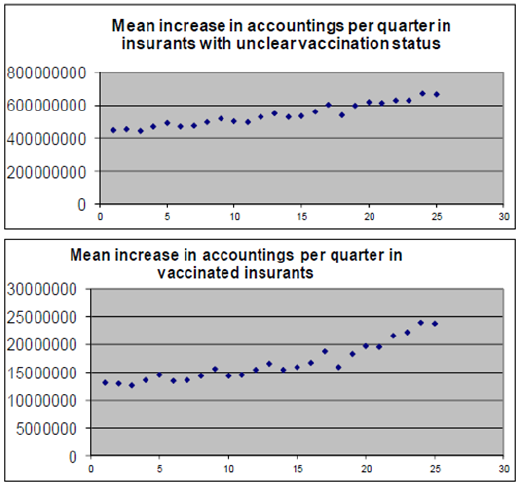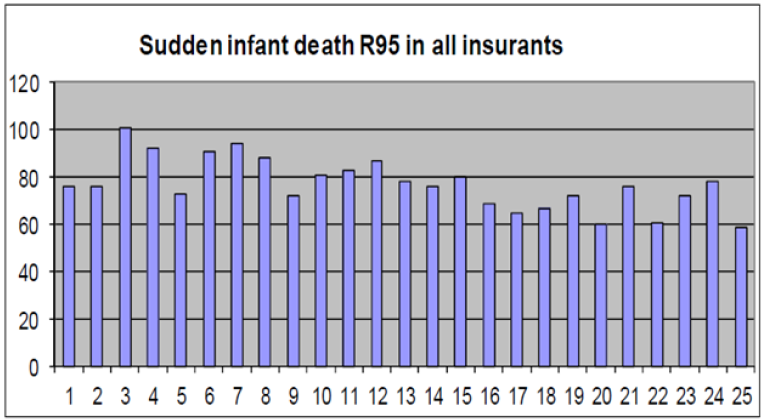Mini Review Article 
 Creative Commons, CC-BY
Creative Commons, CC-BY
Health Insurance Data Hint to Increase in Number of Accountings Per Quarter in About 72 Mio. Insurants of German Health Insurance Providers
*Corresponding author: Johanna Weber, Johanna Weber, Igel Healthcare Services / “Igel Healthcare”, Lehre, Germany Email: jlboulnois@msn.com.
Received: April 14, 2023;Published: April 28, 2023
DOI: 10.34297/AJBSR.2023.18.002505
Abstract
In Germany, data is arriving from health insurance providers regarding a heightened occurance of a variety of ICD-10-Codes in insurants that have been vaccinated against covid as well as insurants with unclear vaccination status. It has to be researched whether there is a significant increase for certain ICD-10-Codes and what consequences could arise for insurants in particular and the German health system as a whole. For this purpose, an anonymized data set from German health insurance providers as collected by the Association of statutory health insurance physicians (Kassenärztliche Bundesvereinigung, KBV) has been analyzed. It is evident that there is an increase in incidence regarding several ICD-10-Codes. Implications for further research have to be discussed in the light of these findings.
Introduction
During the covid-pandemic the German government has encouraged citizens to get vaccinated against the novel coronavirus, SARS-CoV-2. As a consequence, 190.4 million vaccine-doses have been administered.
63.5 million or 76.3 % of the German population have been vaccinated using the novel coronavirus vaccines [1]. In German press releases, discussions have set in regarding potential vaccine side-effects, most recently because of a body of data made publicly available by the KBV [2] (Kassenärztliche Bundesvereinigung). An opinion has been voiced by the KBV-related Central institute of the association of statutory health insurance physicians3 (Zentralinstitut für die kassenärztliche Versorgung der Bundsrepublik Deutschland, Zi) in terms of the number of certain side-effects only rising because of artifacts within the data of the KBV. A scientific analysis of the data is not recommended according to a statement of the Zi [3]. However, certain interpretations are possible when considering the body of data.
Methods
It is understood that all insurants complied with the procedures
administered by their physicians and medical doctors as well as ac
counting by the KBV. Data were collected all over Germany and consisted
of two groups of insurants, which can be viewed separately:
a) Insurants who had been visiting the doctor for any reason
since 2016 (69 573 152 individuals) and
b) Insurants who had been visiting the doctor since 2016
and at the same time had visited the doctor in 2021 with a complication
arising from vaccination with the novel coronavirus
vaccines (2 468 531 individuals).
The latter group can be characterized as the vaccinated group, whereas the first has to be considered as the group with unclear vaccination status, since in Germany it is possible for individuals to be vaccinated against SARS-CoV-2 in vaccination centres without accounting by the KBV. The vaccination campaign in Germany started at the end of December 2020. Since the data arrived in the form of settlements made with the KBV per quarter, it was possible to separate the data into 25 quarters from January 2016 until March 2022, distinguishing 20 quarters before and 5 after onset of the campaign. Statistical analysis was done using Microsoft Excel 2013 and SPSS version 29. A subset of ICD-10 Codes (sum of all codes with the letters A and B for infectious and parasitic diseases, sum of all codes with the letter C for cancers, I46.1 death due to heart problems, I46.9 cardiac arrest, R96 sudden death with unknown cause, R98 death in absence of witness, R99 other unknown causes of death) was analysed regarding their increase in 2021 using Univariate ANOVA.
Results
A significant (p ≤ 0.05) increase in accountings for the sum of all ICD-10 Codes was visible in vaccinated insurants (15298795.35 ± 1987654.53 vs. 22201880.00 ± 1777027.52) as well as in insurants with unclear vaccination status (516577941.20 ± 51596995.51 vs. 641609207.20 ± 24387259.89), while there was a more distinct increase in vaccinated insurants, starting in 2021 (see Figure 1). While the mean number of accountings rose by 45.12 % from 2020 to 2021 in vaccinated insurants, there was only a 24.20 % increase in insurants of unclear vaccination status. The number of accountings per quarter rose by a mean of 2.795 in vaccinated insurants and 1.797 for insurants of unclear vaccination status. The following figures show the increase in accountings for all ICD-10 Codes for both groups of insurants. When calculating ANOVA for ICD-10 Codes related to infectious diseases, there is no significance (p ≥ 0.05) for differences between mean number of accountings in quarters before and after the start of the vaccination campaign in vaccinated insurants (418671.30 ± 57008.53 vs. 478142.00 ± 81851.45) and in insurants of unclear vaccination status (8723322.80 ± 898057.95 vs. 8625524.40 ± 1150936.88). When considering the mean number of accountings per quarter regarding cancer, the number of accountings rose significantly in vaccinated insurants with p ≤ 0.05 and 99373.55 ± 15222.67 vs. 134664.40 ± 7337.82.

Figure 1:Mean increase in accountings per quarter in vaccinated insurants and in insurants of unclear vaccination status.
There was a significant increase in mean number of accountings per quarter (p ≤ 0.05, 141.45 ± 26.34 vs. 233.40 ± 36.21) in vaccinated insurants when comparing quarters before and after the onset of the vaccination campaign for the sum of codes I46.1, I46.9, R96, R98 and R99. The increase was particularly high for the Rcodes, even when considering all insurants and not only the vaccinated (Figure 2).
Discussion and Conclusions
Regarding claims of the Zi, according to which their data was faulty and could thus not be evaluated, it has to be said that apart from minor type errors this is not the case. The body of data was examined accordingly for the purpose of this study, and it was found that it was provided by the KBV as asked for. Furthermore, the Zi claims that there has been a confounding effect on the outcomes regarding the way in which the data set was compiled: insurants that have been visiting the doctor in 2021 cannot have died before that year, so at least for the ICD-10 Codes for I46.1 (death due to heart problems), I46.9 (cardiac arrest) and the codes for sudden death (codes R96, R98, R99), the increase in accountings is an artifact. This is also not the case, as can be shown via analysis of the ICD- 10 Code R95 (sudden infant death of insurants below one year of age). R95 should rise if a confounding effect was present as stated by the Zi, but it does not (see figure 3). This infers that there is no confounding effect due to preselection (Figure 3).
The fact that the R-codes do also rise for insurants with unclear vaccination status can be explained by some of these having been vaccinated in vaccination centers that do not require accounting by the KBV, so there might be a high percentage of vaccinated insurants among those with unclear vaccination status. A significant increase in the number of accountings per quarter in vaccinated insurants is evident for the sum of all ICD-10 Codes next to a not significant increase in the sum of codes A+B and a significant increase for a subset of codes consisting of the codes C, I46.1, I46.9, R96, R98 and R99. The increase in the R-codes was even present in insurants with unclear vaccination status. Vaccinated insurants had a higher need for treatment compared to insurants with unclear vaccination status. Since it is unclear whether these increases were caused directly by the vaccines or by other factors, there is a strong need for further investigation regarding the increase in accountings within the German health insurance system.
Conflict of Interest
The author declares that there is no conflict of interest, no funding was received.
Data Sharing Statement
The data file is publicly available at https://www.kbv.de/ html/2022_61368.php.
References
- (2022) German ministry of health. Vaccination dashboard.
- KBV (2022) Press release. https://www.kbv.de/html/2022_61368.php, 27th of December 2022.
- Zi (2022) Press release. https://www.zi.de/presse/presseinformationen/13-dezember-2022, 27th of December





 We use cookies to ensure you get the best experience on our website.
We use cookies to ensure you get the best experience on our website.